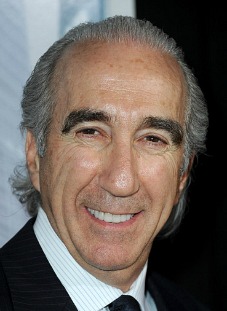“More often than not, we’d be disappointed. It wasn’t the film we dreamed of. It wasn’t the perfect film we each had inside of us. The film we would like to have made. Or, undoubtedly, the film we would have wanted to live.” — an apparent quote from a Godard film that I can’t identify but nonetheless included in “The Empty Screen,” a video essay posted on 2.6.17 by Talkhouse.com‘s Mark Rappaport. Be honest — who has ever wanted to live inside a CG-driven bullshit comic-book fantasy flick? I’ve seen hundreds of films that I would gladly step into and merge with a la The Purple Rose of Cairo, but not once have I ever said “wow…what a beautiful thing it would be to step into a fucking Marvel movie and live in it…not once.”
Daily
Remember Watergate Junkie Highs?
The Trump administration is 28 days old, and already I’m feeling those old expanding/exploding Watergate scandal vibes. Everyone’s blood is up, the sharks are circling…I’m feeling happy again. Especially with the Trump-Russia mishegoss compounded by evidence showing that the FBI suppressed Russian intel while Comey torpedoed Hillary by reigniting the bogus email thing at the last minute. We’re looking right now at strong indications of secretive treasonous collusion with a hostile government run by an Al Capone-like gangster who ices his opponents. Plus a possible pee-pee tape! It’s a Tom Clancy novel, and it’s just starting to heat up.


Comedic Impact Is Peaking
Here’s a reasonably decent National essay about the effect of political comedy on the Washington establishment over the last half-century or so, and more particularly the intersection of comedy, reliable information and rightwing fake news. Nothing startling but a decent summary. The commentator is University of Delaware communications professor Dannagal Young, who performs monthly with a Philadelphia-based improv troupe in addition to her academic tasks.
HRC Guys Didn’t Tape Streep’s Saturday Speech? Captured Only By Shitty iPhone Videos?
From Meryl Streep’s Human Rights Campaign award-acceptance speech, delivered last Saturday evening: “Human life has been organized in a certain way, the hierarchies set, who’s in charge, who makes the laws and who enforces them, pretty much the same way for, oh, about 40,000 years. [And then] suddenly, at one point in the 20th century, something changed. Women began to be regarded as, if not equal, at least deserving of equal rights. Men and women of color demanded their equal rights. People of sexual orientation and gender identification outside the status quo also demanded equal regard under the law. [So] we should not be surprised that fundamentalists, of every stripe, are exercised and fuming. We should not be surprised that these profound changes come at a steeper cost than we originally thought.”
Wrong-Way Festus Has Some ‘Splainin’ To Do
Almost two years after being forced to land on a golf course and banging himself up, Harrison Ford has experienced another private plane mishap. Variety is reporting that after being cleared to land on runaway 20-L at John Wayne Airport, Uncle Festus landed instead on a nearby taxiway. In so doing he apparently came too close to an American Airlines 737 that had 110 passengers plus a six-person crew. What kind of pilot lands on the wrong runway? The first answer that popped into my head: One who’s getting older and not as sharp as he used to be.

Goes Without Saying That Urban Hipster Romcoms Aren’t Aimed At Bumblefucks
The Sundance ’17 smash The Big Sick will open this summer via Amazon & Lionsgate, initially on 6.23 followed by a 7.14 wide break. The lowkey romcom was directed by Michael Showalter, costars Silicon Valley‘s Kumail Nanjiani and Zoe Kazan, and is based on a script by Nanjiani and real-life partner Emily V. Gordon. HE blurb: “Yesterday’s big knockout (and a likely indie-sized hit) was The Big Sick, a diverting, highly original romantic saga — you never really know where it’s going, and that’s just how I like it. Dry, droll, low-key humor for smarties & hipsters. And it really does come together emotionally during the last 25% or 30%. I loved the ISIS and 9/11 terrorist jokes. The only big problem is remembering how to spell and pronounce Kumail Nanjiani — his lead performance is why I suspect Sick will register as an indie-sized rather than a mainstream hit. Best role/performance ever by Zoe Kazan. Hooray for Ray Romano and Holly Hunter as Kazan’s parents.”
Eyes & Nose But There The Resemblance Ends
A slight resemblance between MGM chairman & CEO Gary Barber and the father of our country is duly noted, although Barber’s face is much narrower than General Washington’s.
HE regulars know who Barber is, or more precisely his longstanding policy of malignant neglect towards the 70mm version of John Wayne‘s The Alamo (’60). I’ve been writing for over three years about the refusal of this South African pirate to to allow restoration guru Robert Harris to independently finance a high-def, large-format restoration of Wayne’s epic.


(l.) MGM chairman & CEO Gary Barber; (r.) George Washington sometime during the French and Indian War.
Here’s the whole story. In July of ’14 I persuaded several elite filmmakers to sign a petition in favor of Harris’s restoration plan — Darren Aronfosky, J.J. Abrams, Guillermo del Toro, Alfonso Cuaron, Rian Johnson, Alejandro Gonzalez Inarritu, Bill Paxton, Bob Gale and Matt Reeves among them.
A private request from Harris to Barber was recently passed along through an intermediary, and Barber’s response was akin to the swatting of a fly. Harris only wants Barber’s permission to allow him to save as much of the film as possible. Barber and MGM wouldn’t shell out a single dime, and yet Barber refuses to budge, a mule to the last.
Odds-On Favorites
The heavier the minus/negative rating, the more likely the winner. The higher the plus/positive rating, the lesser the chances. I hate betting, Las Vegas, odds (“Never tell me them!”), poker and poker faces, Atlantic City and Native American casinos (especially the one in Morongo). I hate any horse or dog track. I used to love the sound of silver dollars clattering into the tray when you got lucky with dollar slots, and now that’s gone. I hate roulette, Jai Alai, passing the shoe, fucking blackjack. I hate cold cards, Glitter Gulch, Texas Hold’ Em, anything “according to Hoyle.” I hate Reno and Monte Carlo, pit bosses, Gardena card clubs and those jerkwater slot machines in McCarran Airport. The only thing I like about any aspect of this entire sickening realm is Robert Altman‘s California Split (’74) and Ed Norton‘s performance in John Dahl‘s Rounders (’98).



No, No, A Thousand Times No
No Japanese media franchise bullshit, no Paramount cash-in, no Rupert Sanders, no seinen manga, no Scarlett Johansson paychecks…none of it, forget it, I will not look at thee.
Click here to jump past HE Sink-In

The performances we tend to remember and celebrate are always about recognizable feelings shaped by people who know from timing, emphasis, discipline…the art of emotional channeling. But different folks come at this in different ways. Among the current Best Supporting Actress nominees, four are similar and one is slightly different.
Fences‘ Viola Davis, Moonlight‘s Naomie Harris, Lion‘s Nicole Kidman and Manchester By The Sea‘s Michelle Williams are skilled actresses channelling the emotions of four exceptionally well-written characters. Hidden Figures Octavia Spencer, on the other hand, is a shrewd, spunky, spiritually attuned woman who knows how to shade or accentuate her natural manner and personality just so to bring out the contours of a fresh character.
In other words Davis, Harris, Kidman and Williams “act” to achieve a certain carefully refined end while Spencer is more of a natural presence who’s gifted and skillful enough to have made the right adjustments. The other four are like instruments — Spencer is more of a river or a force.
Popular actors and actresses are bringers of dependable vibes. The transition from popularity to stardom is basically about those vibes becoming well known, trusted and embraced en masse. I don’t know exactly when this started to happen with Octavia Spencer, but I know it’s happening right now. She’s become our best friend, our neighbor, a lady with heartstrings, someone you want along for the ride but at the same time a tough cookie. Plus she has the kindest eyes my own have ever beheld.
Just don’t forget the tough cookie part. Something about Spencer says “Sure, I’ll listen and probably hear what you’re saying ’cause I’m a generous empathy type plus you look like a nice fella, but don’t pull any fast ones when my head is turned or I’ll come down on your ass.”
Most of us decided we not only liked the water in Octavia’s well but wanted to keep a few bottles in the fridge after seeing her in Tate Taylor‘s The Help. Spencer won the Best Supporting Actress Oscar for her performance as Manny Jackson, the too-long-taken-for-granted maid. I’ve long presumed that Spencer won because of the shit-pie sequence, but more precisely because she allowed us to fully feel what Minny had gone through with her employer, played by Bryce Dallas Howard.


